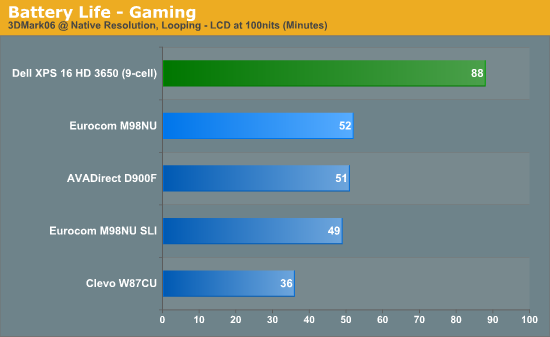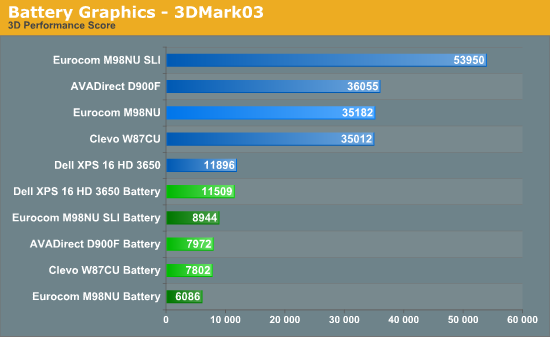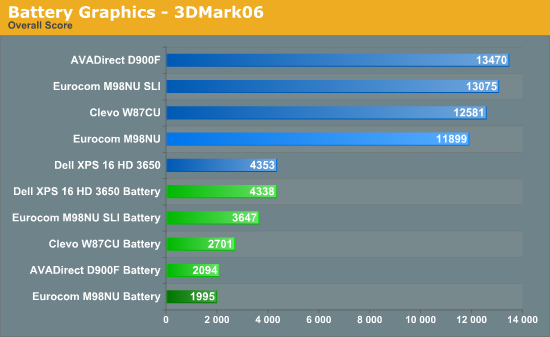The Highest-End Notebooks, 2009
by Jarred Walton on October 14, 2009 3:10 AM ESTMixing Gaming with Batteries
One final area we wanted to investigate before wrapping things up is battery life while gaming. This is something we've hinted that in the past, but we decided it was time to provide real data. There's a mistaken notion that these high-end gaming notebooks can still provide almost an hour of battery life while still delivering a better gaming performance than other laptops. The problem with that assumption is that the notebook manufacturers force the GPUs to run in lower-power modes while using the battery, apparently because the battery can deliver enough power. The GPUs aren't the only part to have lower performance on battery power, as we also noticed CPU performance dropped (regardless of power saving setting). We'll focus primarily on graphics for these tests, turning to 3DMark as a repeatable benchmark.
Let's start with battery life looping 3DMark06 at the native LCD resolution. For reference, we are including the Dell Studio XPS 16. Our version comes with the ATI Radeon HD 3650, which is slower than the latest models that use the HD 4670. We're using the 9-cell battery in this test, which is 85Whr (12% smaller than the D900F battery).

Okay, the Dell Studio XPS comes out on top. We were all expecting that, right? A dual-core CPU with a graphics chip that provides around one fourth the performance of the GTX 280M should last longer. But that's just looking at the duration of battery life. Now let's look at the actual benchmark results for the various 3DMark applications. Note that we had to use an external LCD for the W870CU in 3DMark06 and 3DMark Vantage to run at 1280x1024, which may account for its higher performance relative to the other two desktop replacement systems.




Okay, first things first: we ran each test several times on battery power, taking the highest result. There was more fluctuation than we're used to seeing -- sometimes as much as 30%. Or rather, there was fluctuation on all of the high-end notebooks; the Dell Studio XPS 16 was extremely consistent by comparison. We disabled all power saving features in an attempt to achieve maximum performance on battery life; in reality, there wasn't a major difference between the "Balanced" and "High Performance" profiles (less than 3%).
The big surprise is that the Studio XPS 16 doesn't need to run the graphics in "limp mode", so performance remains essentially unchanged (although you can run the GPU at reduced performance to improve battery life if you so desire). So what do you get with an extremely heavy, powerful desktop replacement notebook when you run on battery power? Oddly enough, you get less performance than a midrange mobile GPU. We haven't performed this test with a lot of other notebooks, but we can say for sure that we were unable to improve graphics performance on battery power for the three tested notebooks. Again, using all the "maximum performance" settings and the "High Performance" power profile, we still couldn't get the GPUs to run at anything other than extremely low clock speeds. Good for battery life, yes, but not for gaming.
Then again, let's not get too concerned about this: if the graphics were running at full power, the D900F and M980NU can consume over 200W, while the W870CU maxes out at around 150W. That means you would get around 15 minutes of battery power if the notebooks didn't limit performance (assuming the battery would even provide enough juice). Long story short, don't plan on intense 3D gaming while on battery power. If that's what you're after, you would be better off settling for a midrange laptop.










56 Comments
View All Comments
MonicaS - Friday, October 30, 2009 - link
I think the best way to get a high end laptop is to build one. Obviously you are very limited in what you can with a laptop over a desktop, but still the options are enough. The obvious upgrades are HD and Ram. On that note you can Raid to SSD's and put in some serious ram on a 64 bit machine and have a incredibly fast machine. The other benefit of this is that you can basically pick your own laptop to upgrade and not have to buy fugly one.Monica S
Los Angeles Computer Repair
http://www.sebecomputercare.com">http://www.sebecomputercare.com
Shadowmaster625 - Thursday, October 22, 2009 - link
"Unfortunately, 60GB isn't enough space to install even a small subset of our gaming benchmarks"All you have to do is move the game folders to the big drive when you're not using them, and move them back over to C:\Program Files when you need to use them. It takes all of 2 minutes (or 10 seconds for a multitasker) and is surely smarter than wasting hundreds of dollars on bigger SSDs, no? Are we that lazy?
Draxanoth - Thursday, October 22, 2009 - link
I see a lot of complaints for no good reason in these comments. If you don't like them, don't buy them. Complaining about something you don't own nor want sounds like bitterness at the price tag.I have an M570etu, which is the dual core version of the GTX280 Clevo model with the orange trim. It's a lot better looking in person, those pictures are awful. 3.2ghz I think but I'd have to check. My battery life is 3 hours non-gaming. It easily functions as both a mobile and a gaming machine. I don't have any problems with Call of Pripyat in HD either. i7 in a laptop is overkill, and if you want one with a decent battery life that's a poor choice. Why is anyone surprised by that?
Meaker10 - Saturday, October 17, 2009 - link
You can already get official mobile drivers for all laptops for windows 7 the same version as the desktop set for the HD 2,3 and 4 series.JarredWalton - Saturday, October 17, 2009 - link
True, but the real question will be whether this is a one-time thing (because Win7 is launching and ATI has to have valid drivers or they'll be in deep trouble), or if this is a change going forward. I'm inclined to think it's just for the Win7 launch, since they don't provide mobile drivers for anything besides Win7. Vista and XP users are still the vast majority of people and will be for a good while to come, and there are laptop users that literally haven't received updated ATI drivers in years.I'll keep an eye on things, and hopefully ATI will change their stance officially at some point. At present, searching for ATI Mobility Radeon drivers for XP and Vista only gives you the choice of X1800 or earlier GPUs. It looks like perhaps the integrated HD 3200 on laptops might also have up-to-date drivers in XP/Vista, but discrete GPU laptop owners are out of luck for now if they don't upgrade to Win7.
jmhorridge - Saturday, October 17, 2009 - link
I and my work colleagues must regularly fly to other countries for a week or two, and there perform computations (economic forecasting) that can occupy a quad-core for 2 or 3 hours. These big DTR laptops (or luggables) are the only way to get the job done. Battery life is not an issue -- always used plugged in.An mATX system (with monitor) would weigh twice as much, might not suit all voltages, and, in a suit case, would bust the flight weight allowance. However, everyone is allowed to carry on a laptop -- no matter how big.
I'm very pleased to see such machines reviewed.
Mark Horridge
Kishkumen - Friday, October 16, 2009 - link
"it appears most notebook manufacturers are convinced users aren't interested in matte LCDs anymore."Then they are wrong and I will not buy their product. I've passed up some pretty awesome notebooks over the past couple of years. Looks like I'll be passing up many more. If I'm the only one who can't stand glossy displays, then so be it, but I'd rather go without then pay good money for something that is the visual equivalent of fingernails on a chalkboard for me.
EBH - Thursday, October 15, 2009 - link
Falcon NW should have been in the review. Their machines > than any Aienwarehttp://www.falcon-nw.com/">http://www.falcon-nw.com/
JarredWalton - Friday, October 16, 2009 - link
I'm not sure why you say Falcon is so much better than Alienware. They're basically the same thing as AVADirect, but with far fewer options.Fragbox DRX = Clevo D900F with custom paint.
Fragbox TLX = MSI MS-1722 (GX720) with custom paint.
I/O = MSI MS-1361 (X340)with... yup, custom paint.
AVADirect also offers all three of those, with optional custom paint. Pricing definitely isn't in favor of FNW, though perhaps they have better customer service. Let's see, using as close to identical options as I can get (including custom paint on the AVADirect models):
D900F AVADirect = $4545
Fragbox DRX = $6086
MSI GX720 AVADirect = $2229
Fragbox TLX = $2625
MSI X340 AVADirect = $1292
I/O = $1727
I think the main draw of Falcon is if you want a special paint job with some custom image (i.e. not just the Exotix Single Color option). That can add over $1000, but at least then you have something truly unique. Anyway, inasmuch as performance and features are concerned, Falcon was in this review, albeit indirectly. The same goes for WidowPC and ProStar and anyone else that uses whitebook chassis.
nortexoid - Thursday, October 15, 2009 - link
I'm sure most would be better off buying a desktop (of the same caliber) and a cheap netbook for mobility, and for the same price as these ghastly beasts.The only market I can see for these things is someone who goes to LANs more often than he should, and who would rather port around a 10lb+ notebook than a desktop + LCD or all-in-one. But this has to be a very small niche market.